Considering my total fascination with Denali, visiting Talkeetna was
high on my list of things to do in Alaska. Climbers are required to
begin their orientation and obtain their permits here.
Although I'll never climb North America's highest peak, I just had to
learn more about the history of climbing Denali. Fortunately, Talkeetna
is located only 14 miles off the Parks Highway on a good paved road and
was an easy side trip today on our way to Denali State Park:

Talkeetna Spur Hwy. and bike path
both run 14 miles from the Parks Hwy. to town.
Here's the
map section from The Milepost website
that I used in the last entry to show the proximity of Talkeetna, Denali
State Park, and Denali National Park & Preserve:
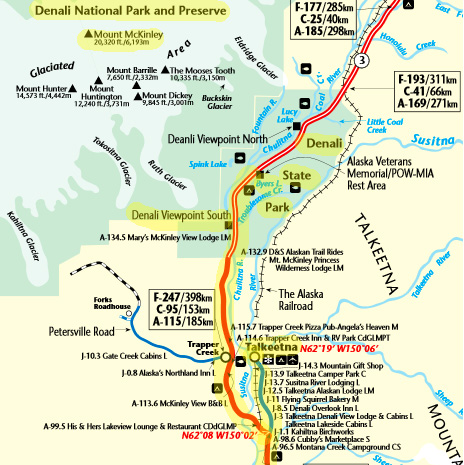
That's just the southeast part of the huge national park.
Note the location of Mt. McKinley, which I prefer to call Denali, its
Native Alaskan name. By air it is about 60 miles from Talkeetna to the
summit of the mountain. Not that you can land there, though .
. .
VISITING TALKEETNA
It would have been more fun to tour this funky little town if it hadnít
been raining and chilly but we made the best of it.
Not only is Talkeetna perfectly situated for spectacular views of Denali (on a
clear day), the town is also popular because of its artsy residents,
imaginative businesses, and the mystique of the mountain-climbing
community that spends time here every spring and summer.

One of
the more colorful businesses in town, Mountain High Pizza Pie

Above and below: rustic home of one of the
residents (Grizzly Gold, maybe??)


Equally rustic shop located near the Talkeetna
Ranger Station
Originally I thought weíd leave the camper along the Parks Hwy. and just
drive the truck 14 miles up to Talkeetna since it is a small town and
weíd heard there isnít much parking for large RVs.
Since it was raining we decided to just drive on into town with the
Cameo.
That worked out OK this time. We found a spot to park along the street
across from the Denali National Park Ranger Station/Visitor Center. That
was pure luck because there wasnít room anywhere else in town today that
we could see for a large rig.
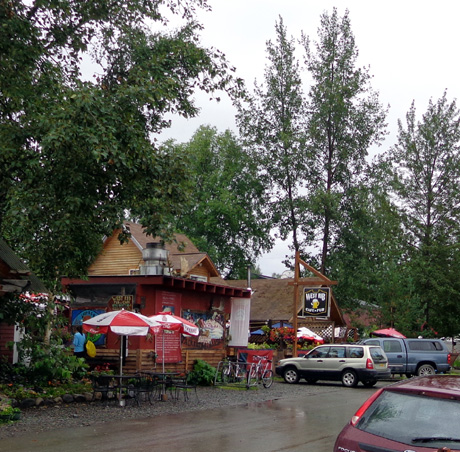
The main street has room for passenger vehicles or
small RVs
but not big rigs, even on a rainy weekday in the
summer.
Keep that in mind if you're driving an RV to Talkeetna. You may well
have problems finding a place to park it on a sunny day or weekend when
there are even more people visiting the town than there were today.
We spent about two hours in Talkeetna from approximately 1-3 PM.
We could easily have spent a lot more time than that if we weren't
focused on getting a campsite up the road before suppertime.
THE LURE OF CLIMBING
N. AMERICA'S HIGHEST MOUNTAIN
We went into the ranger station first, which was a good thing.

After we briefly walked
around the inviting lodge-type room with all the climbers' banners and
flags we went over to talk to the ranger on duty:

Inside the Talkeetna Ranger Station



The ranger told us to walk right away about 200 yards to another
building in the historical societyís complex to hear a ranger talk about
climbing Denali. We didn't realize it, but this summer the talks are
given at 10:30 AM and 1 PM. We're lucky we got there when we did.
We passed an old faded red building that used to be a school (built in 1936)
and is now the historical society museum:

The Denali speech is done only twice a day in the mustard-colored
Railroad Section House behind the old school:

It features a 12x12-foot model of Denali and surrounding mountains. The
main climbing routes are marked on it. There are also lots of historical
pictures of the climbs, old and new climbing equipment, and other
exhibits.
We got there just after the 1 PM talk began and I waited until after the
ranger was done speaking to take pictures. The room was pretty crowded
during his talk,
with folks standing all around the large model in the middle of the main
room.

The ranger stuck around after his talk to answer
guests' questions.
We could hear and see the ranger clearly, though. He talked about the
procedures all the climbers have to go through before they are permitted
to climb the mountain, mentioned some of the rules (no oxygen, carry out
your poop and trash, etc.), showed us photos of the various camps along
the way, and gave all sorts of other interesting information.
He stressed safety procedures and emphasized how important it is to
respect the mountain on various levels (environment, weather, etc.).
About 1,200 people attempt to summit Denali each year between the end of
April and the beginning of July. The average summit rate is 50%. This
year it was only 40%:

No mention of the six climbers who died up there
this year . . .
Bad weather is one of the main reasons people fail to summit. Inadequate
training, injuries, and altitude sickness are others.
Rangers are located at two levels on the mountain to deal with illness,
injuries, and rescues (about 11,000 feet and the camp at 17,400 feet).
They stay for a month so they are well-acclimated.
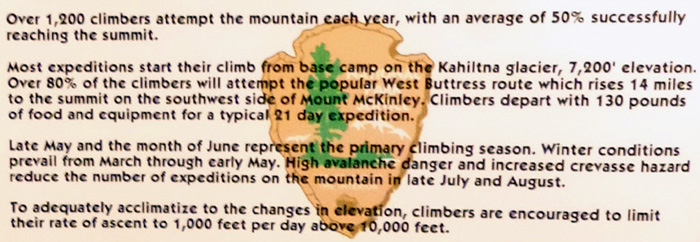
Climbers are encouraged to spend several days at each of four or five
levels so they can acclimate adequately. It takes two to three weeks for
most folks to safely get to the summit and only a couple days to
descend.
Most of the accidents and deaths occur on the descent when people are
tired and more careless.
Or, as the ranger dryly observed, in too big a
hurry to get down and post their comments on Facebook!
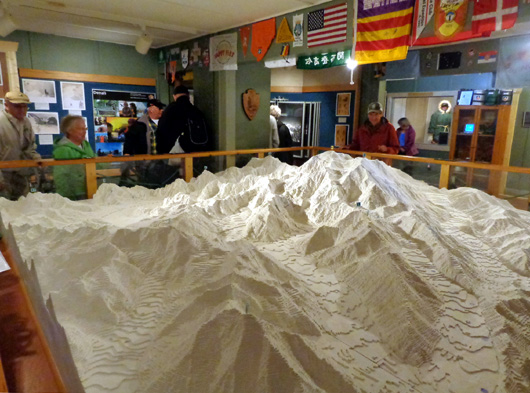
Visitors can walk on all four sides of the large
scale model of Denali and surrounding peaks.
I loved all the colorful flags and banners
representing countries climbers have come from.
This year six
climbers died from injuries sustained on the mountain. Five died in
2011.
I don't often
rely on articles from Huff Post (or Wikipedia) for my information but
this article is pretty interesting about the historic death count on
Denali (reportedly 120 people since 1932) and the number of bodies that are still
up there (reportedly 44, including four Japanese climbers who
disappeared during an avalanche in mid-June).
[Addendum for 2013: according to this web article by
Anchorage Daily News dated July 19,
2013 a record number of climbers reached Denali's summit, a total of 787
people. The number of registered climbers was fairly low -- only
1,151 people. That resulted in a successful summit percentage of 68%, the
highest in 36 years. There was only one death in 2013.]

The various climbing routes up Denali are marked on
the model.
The West Buttress route is the most frequently
used.

This feature is cool: if you stand at each
corner of the model and look across the room,
there is a large B&W photo of Denali on the
opposite wall from the same angle as the model.
As we listened to the ranger Jim and I were both independently thinking
how we would have wanted to climb Denali if we were younger. Ten or
fifteen years ago we maybe could have done it. Now we canít in our 60s
because of our bum knees and decreased level of fitness.
Itís not the first time this summer that Iíve regretted not coming to
Alaska much earlier in my life.
After the talk we returned to the ranger station to see a companion film
about climbing Denali. We highly recommend watching that, too.
OTHER TOURIST ACTIVITIES
Then we walked around town for about 30 minutes. Talkeetna has some
interesting old buildings and is on the National Register of Historic
Places.
There are all kinds of interesting houses, gift shops, art exhibits, eating establishments,
adventure companies (rafting, flight-seeing, horseback rides, etc.),
historic Nagley's General Store, the old Talkeetna Roadhouse dating back
to gold rush days, a visitor center, museums, lodges, etc.
Here are photos of a
few of them:

The historic
Talkeetna Roadhouse, built in 1917, still offers rooms and meals to
travelers.

Old Fairview
Inn
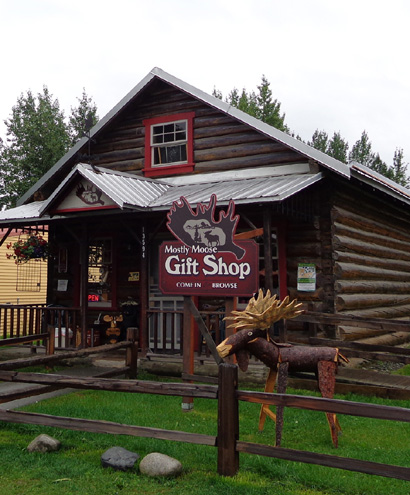
One of
several gift shops featuring Alaskan-made items

Above and
below: interior of the Dancing Leaf Art Gallery

We didnít go into the historical society museum (old red schoolhouse)
but should have. We simply forgot about it when we were ready to leave. The Railroad Section House
where we listened to the ranger speak about climbing Denali is part of
the group of buildings in this museum.
The schoolhouse has a variety of historical exhibits. This photo of the
original white schoolhouse built in 1936 was on an interpretive panel
outside the building:

The schoolhouse was painted red in
the late 1950s and looks almost pink now from getting so faded.
A third building, the Ole Dahl Cabin, is an early trapper/miner's cabin
that is furnished with period pieces:

Talkeetna looks like a fun place on a sunny day. There were lots of
people walking around even on a rainy Thursday.
Because of the rain no flights went out today from Talkeetna to view
Denali or the glaciers in the national park, per a young lady at K2 Aviation, a company
several people have recommended to us for a flight tour. We're still
researching the various air companies and haven't
purchased our tickets yet.

K2 Aviation's sales office in Talkeetna

Talkeetna Air Taxi
also has an art gallery inside its office.
On the way back to the camper I walked over to the fast-flowing
Talkeetna River with Cody.
The town of Talkeetna was built at the
confluence of three large rivers Ė Talkeetna, Susitna, and Chulitna.
This is supposed to be one of the Denali viewpoints but there was no seeing
The High One or the rest of the Alaska Range through all
those clouds today:

According to The
Milepost book (2011, p. 408), "Talkeetna began as a trading post in
1896 and grew as a riverboat supply base following the Susitna River
gold rush in 1910. The population boomed during construction of the
Alaska Railroad . . ."
There is a lot to do
in Talkeetna. I've barely scratched the surface here.
If you aren't staying
in the little town overnight it's well worth a day trip if you're lodged
at Denali National Park or down toward Anchorage. I'd like to go
back on this trip or our next one to Alaska and spend more time browsing
the shops and eating at one of the restaurants -- on a day
when it isn't raining!
Next entry: camping at Byers Lake in Denali State Park
Happy trails,
Sue
"Runtrails & Company" - Sue Norwood, Jim O'Neil,
and Cody the ultra Lab
Previous
Next
© 2012 Sue Norwood and Jim O'Neil






























